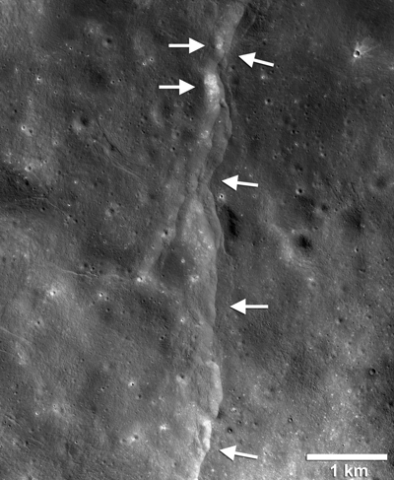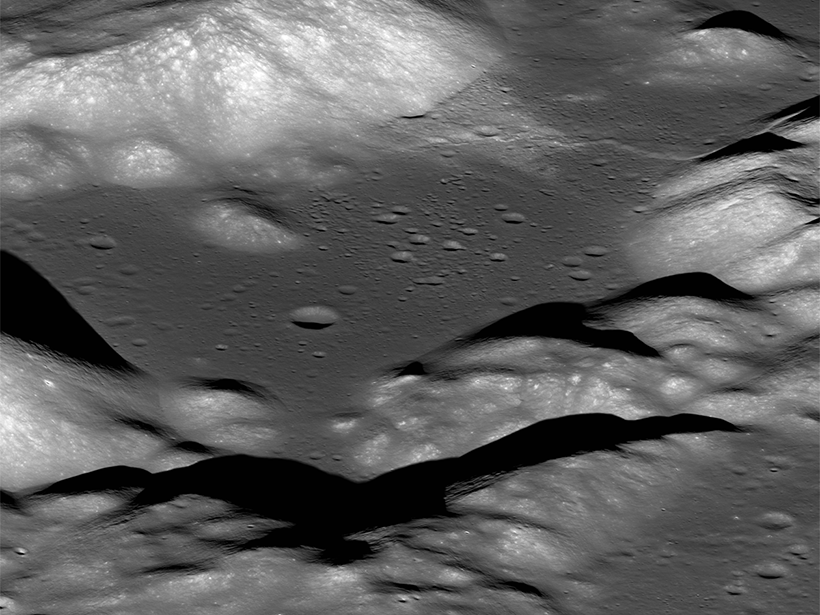Between 1969 and 1977, lunar seismometers at four Apollo landing sites recorded 28 shallow moonquakes. However, the data transmitted by those seismometers were low resolution by current standards, making it difficult to locate the moonquakes’ epicenters.
Decades later, analysis of high-resolution images taken by the Lunar Reconnaissance Orbiter Camera (LROC) “revealed a vast, global network of lobate fault scarps,” researchers wrote in a study published on 13 May in Nature Geoscience. These formations likely resulted from thrust faults left behind as the Moon shrank like a raisin because of its interior cooling. The new study presents compelling evidence that the Moon is still tectonically active.

Researchers used a new algorithm designed for sparse seismic networks to constrain the epicenter locations of these moonquakes. The relocation algorithm used uncertainties in the arrival time of body waves to generate a cloud of possible epicenter locations for each moonquake.
The team also created what might be the first shake map of the Moon, according to lead author Thomas Watters, a coinvestigator on the LROC and director of the Smithsonian Regional Planetary Image Facility at the National Air and Space Museum in Washington, D.C. The epicenters of eight of the quakes were located within 30 kilometers of fault scarps, a distance at which strong shaking likely occurred, according to the shake map.
The orbital timing of these quakes was also significant. Seven of them occurred at near apogee, when compression of the Moon is near its maximum and fault slip events are likely to occur, according to the study. The team concluded, on the basis of the nearness of the moonquakes to the thrust faults, along with the presence of regolith disturbance and boulder movement on and near the geologically young fault scarps, that the Moon is probably tectonically active.
“Overall, this is an interesting study because it presents evidence for a potential link between seismicity and faulting on a planetary body other than Earth,” Christian Klimczak, a structural geologist at the University of Georgia in Athens who was not involved with the study, wrote in an email.
Need for More Data, More Maps, More Research
Still, more data are needed “before we have the smoking gun” that the moonquakes and the lobate scarps are related, said Nicholas Schmerr, a coauthor on the study and a planetary seismologist at the University of Maryland in College Park.
Although these results illustrate an exciting discovery, they also show the need for putting modern seismometers on the Moon.
Analyzing the Apollo era data on the shallow moonquakes shows that “not all of them are well above the noise,” Schmerr said. Therefore, although these results illustrate an exciting discovery that is the product of combining decades-old Apollo data with images collected by the LROC, they also show the need for putting modern seismometers on the Moon.
Some of the moonquakes “did not have a strong association with a lobate scarp,” Schmerr said. In the future, researchers want to investigate whether those quakes are instead associated with wrinkle ridges. However, they first need to create a comprehensive map of the ridges and better constrain the ages of those features, he said.
Researchers still need to find and image more of the faults, Watters said. This will help them better plan to avoid seismic activity on future extended missions. When humans are ready to build lunar outposts, having data on the locations of faults will also help scientists decide whether to place them in areas where strong shaking is unlikely or to create structures that can withstand the shaking, he said.
“With the recent landing on Mars of the InSight mission, we’ve shown that it’s possible to remotely land and operate a seismometer on another world, and it’s far easier (and faster) to get to the Moon than to Mars,” Paul Byrne, a planetary geologist at North Carolina State University in Raleigh who was not involved with the study, wrote in an email. “So hopefully we’ll see, within the next few years, more seismic data being collected for the Moon, which can be used to bolster this kind of work and tell us just how seismically active our nearest neighbor is,” he added.
—Rachel Crowell (@writesRCrowell), Science Writer
Citation:
Crowell, R. (2019), The quaking, shrinking Moon, Eos, 100, https://doi.org/10.1029/2019EO125207. Published on 30 May 2019.
Text © 2019. The authors. CC BY-NC-ND 3.0
Except where otherwise noted, images are subject to copyright. Any reuse without express permission from the copyright owner is prohibited.

